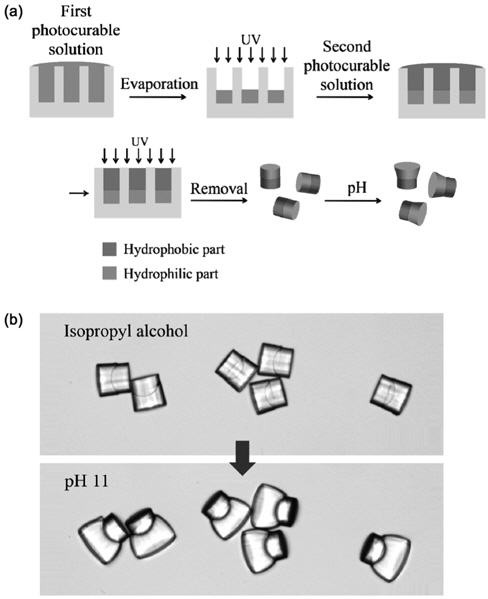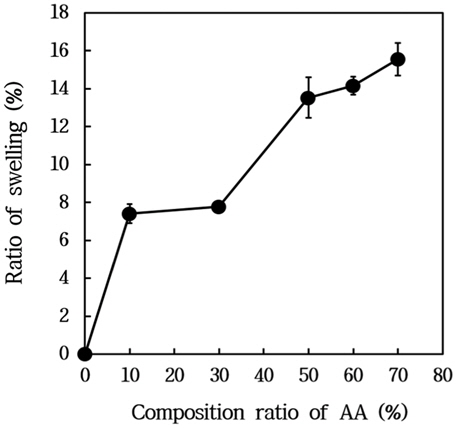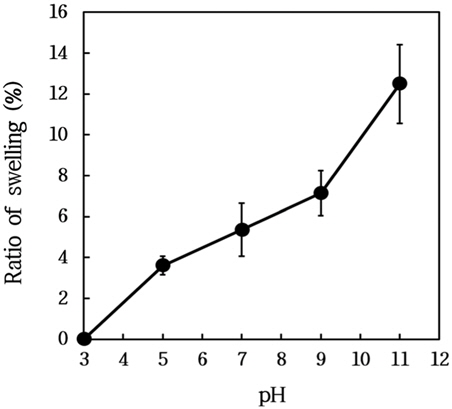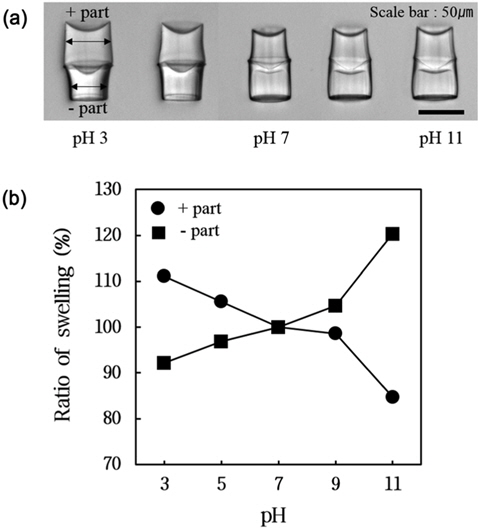



This study presents a micromolding for the synthesis of Janus particles with reconfigurable shape by pH stimuli. First, we use acrylic acid (AA) as pH responsive monomer in the hydrophilic part and trimethylolpropane triacylate (TMPTA) in the hydrophobic part, respectively. The change of acidity in solvent induces the swelling of hydrophilic part in the Janus particles. The pH-responsive Janus particles show different swelling ratio of hydrophilic part in according to composition of acrylic acid in diverse range (0-70% v/v) and pH (3-11). As the concentration of acrylic acid in the hydrophilic part and environmental pH increase, the hydrophilic part in the Janus particles is proportionally swelled. Second, we fabricate novel type of Janus particles with two different hydrophilicities. As a proof of concept, we have applied acrylic acid (AA) and 2-(dimethylamino)ethyl methacrylate (DAEMA) into each part because the monomers provide reverse responsive activity. As expected, these Janus particles show different shape anisotropies with reconfigurable property in accordance with the polarity of each part at same acidity of environmental solvent. We envision that the stimuli responsive Janus particles have a wide application from fundamental science to diagnostic apparatus.
외부 자극에 응답하는 입자는 미세한 외부 환경의 변화에 반응함으로써 물질의 물리/ 화학적 특성이 제어되는 장점이 있으며, 이로 인하여 조직 공학[1-3], 약물 전달 시스템[4-7], 바이오 센서[4,8-10] 등 정밀함을 필요로 하는 의료 및 재료산업 분야에 널리 응용되고 있다.
이러한 자극 응답형 입자는 온도[11-13], 산세기(pH)[14-17], 빛[18-20] 등과 같은 다양한 외부 환경 변화에 의해 반응한다. 특히 자극 응답 특성은 자연에서도 쉽게 관찰할 수 있다. 예를들어 솔방울의 경우, 자체의 수분을 유지하기 위해 건조한 환경에서는 비늘을 열어 표면적을 넓히고, 반대로 습한 환경에서는 비늘을 닫아 표면적을 줄이는 경향을 보인다[21]. 이는 자연계에서도 외부 환경의 변화에 반응하여 가역적으로 변화할 수 있는 특성이 중요하다는 것을 암시하고 있다고 말할 수 있다[22].
하이드로젤은 수용액 상에서 유연성을 가지며 물리/화학적 특성을 조절하기 쉬운 장점 때문에 많은 분야에서 대표적인 자극 응답형 물질로 응용되고 있다[23-25]. 예를 들어 온도 응답형(thermo-responsiveness) 물질인 poly (N-isopropylacrylamide)을 사용하여 얇은 필름을 제조하여 온도에 따라 가변적으로 형상을 변화시킬 수 있음을 보여주었다[11]. 또한 광응답형(photo-responsiveness) 물질인 azobenzene이나 spiropyran 등을 사용 하여 제조된 물질은 외부 자극인 빛을 조사함에 따라 다양한 광학적 특성을 보여주었으며[18], 산세기의 변화에 따라 채널 내에서 밸브 역할을 수행하거나[16] 하이드로젤 입자에 약물을 함유하고, 팽윤과 수축 되는 성질을 이용하여 특정 지역에 약물의 전달 가능성을 보여주었다[26]. 그 중에서 산세기 응답형 하이드로젤의 경우, 서로 다른 이온화 경향성을 갖는 두 가지 이상의 산세기 응답형 물질을 사용하여 하나의 입자에서 서로 다른 모양 변형을 보여주는 연구가 활발히 진행되고 있는 추세이다[27]. 이러한 야누스 입자를 제조하는 대표적인 방법은 그래프팅(grafting from, grafting to)[28], 공급된 에멀젼 중합(seeded emulsion polymerization) 방법이 있다[29]. 하지만, 위의 방법으로 제조된 입자들은 공정 상 계면활성제를 사용해야 하므로 친환경적이지 않으며, 입자의 크기가 균일하지 않다는 한계점을 갖고 있다. 이를 해결하기 위하여 본 연구에서는 계면활성제를 사용하지 않고, 높은 균일성의 입자를 얻을 수 있는 마이크로 몰딩 기술을 사용하였다.
본 연구에서는 동일한 외부 자극에 대하여 각기 다른 팽윤 및 수축 응답 특성을 나타내며 이로 인하여 비등방성 모양 변형이 가능한 야누스 입자를 제조하였다. 야누스 입자를 제조하기 위하여 종래에 잘 알려진 소프트 리소그래피 방법(soft-lithography)을 통하여 미세 몰드를 제작한 후 몰드에 광중합이 가능한 단량체 용액을 채운 후 이를 광중합을 시켜 입자를 제조하였다. 입자 제조시 사용되는 단량체 조성을 다양화 함으로써 팽윤, 수축 정도 및 모양 변형 정도를 제어 가능함을 보여주었다. 또한 입자의 외부 환경의 산세기 조건을 다양하게 조절하였을 때, 야누스 입자의 모양 변화를 관찰 및 분석 하였다. 더 나아가 야누스 입자의 각기 다른 부분에 서로 다른 극성을 갖는 산세기 응답형 단량체를 사용함으로써 동일한 환경에서 서로 다른 응답 특성 및 이를 통한 입자의 형상제어가 가능함을 보여주었다. 이를 통해서 본 연구에 사용된 산세기 응답형(pH-responsiveness) 야누스 입자는 산세기에 따라서 다양하게 이방적인 모양 변형 특성 및 팽윤, 수축 특성을 갖는 것을 증명하였다.
야누스 입자 합성을 위하여 사용된 2-hydroxyethyl acrylate (HEA), acrylic acid (AA), poly ethylene glycol diacrylate (PEGDA, Mn = 700), trimethylolpropane triacylate (TMP-TA), 2-(dimethylamino)ethyl methacrylate (DAEMA), 2-hydroxy-2-methylpropiophenone (Darocur 1173) 및 Ethanol (≥99.5%)은 Sigma-Aldrich chemicals (MO, USA)에서 구매하였다.
2.2. 산세기 응답형(pH-responsiveness) 야누스 입자의 제조
몰드를 이용한 모양 변형성을 갖는 산세기 응답형 입자의 제조는 다음과 같이 수행된다(Figure 1(a)). 먼저, 널리 알려진 소프트 리소그래피 기술(soft-lithography)을 이용하여 PDMS (polydimethylsiloxane) 미세 몰드를 제작 하였다[30-32]. 간략하게는 포토 리소그래피 공정(photo-lithography)을 통해 실리콘 웨이퍼에 SU-8을 사용하여 원기둥 형태로 패터닝 한 후, PDMS 올리고머(Sylgard 184)와 경화제(curing agent)를 10:1의 비율로 섞은 용액을 SU-8이 패턴 된 웨이퍼 위에 부어준다. 부어진 PDMS를 65 ℃ 오븐에서 6시간 동안 열경화를 시켜준 후 경화된 PDMS 몰드를 웨이퍼에서 떼어 낸 후 사용하였다.
이렇게 만들어진 미세 몰드에 자극 응답성을 가지는 친수성 단량체 용액(HEA/ AA / PEG-DA/ Darocur 1173 / Ethanol)을 PDMS 몰드의 음각 패턴 안에 넣어준다. 잔여 단량체 용액은 피펫으로 제거해 준 후에 2분 동안 자외선을 조사하여 광중합 방법을 수행한다. 이때, 첫번째 단량체 용액에 혼합하는 에탄올의 함량에 따라 자극 응답성 부분의 높이가 제어가 가능하며 이를 통해 더욱 다양한 비등방성 야누스 입자의 제조 또한 가능하다. 다음으로 광중합이 가능한 두번째 소수성 단량체 용액(TMPTA/Darocur 1173)을 넣어준 후 남은 단량체 용액은 피펫으로 제거해주고 자외선을 2분간 조사하여 광중합을 시켜 주게 되면 서로 다른 화학적 특성을 가지는 야누스 입자를 합성할 수 있다. 이때, 사용한 단량체 용액의 조성은 다음과 같다(Table 1).
[Table 1.] Composition of photocurable solution for synthesis of pHresponsive Janus particles
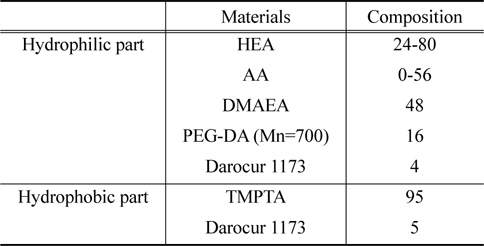
Composition of photocurable solution for synthesis of pHresponsive Janus particles
2.3. 양극성을 갖는 산세기 응답형(pH-responsiveness) 야누스 입자의 제조
몰드를 이용한 양극성 야누스 입자의 제조는 위와 동일한 공정으로 수행된다(Figure 1(a)). 첫번째로 PDMS 몰드에 음전하를 갖는 친수성 단량체 용액(HEA / AA / PEG-DA / Darocur 1173)을 넣어준 후 2분간 자외선을 조사하여 광중합 방법을 수행한다. 두번째로 양전하를 갖는 단량체 용액(HEA / DMAEA /PEG-DA / Darocur 1173)을 넣어준 후 2분간 자외선을 조사하여 광중합 방법을 통해 서로 다른 전하를 가지는 양극성 산세기 응답형 야누스 입자를 제조할 수 있다. 이때, 사용한 단량체 용액의 조성은 다음과 같다(Table 1).
본 논문에 사용된 광학이미지는 CCD (charge-coupled device) 카메라(coolsnap, roper science, USA)가 장착된 광학현미경(NIKON, TE2000, Japan)을 사용하였다. 촬영된 이미지는 Imagepro plus (Media cybernetics, CA, USA)프로그램을 사용하여 팽윤율을 분석하였다.
제조된 야누스 입자의 자극 응답형 특성을 용액의 산세기 조절을 통하여 확인하였다. isopropyl alcohol (IPA)에서 야누스 입자는 원기둥과 비슷한 형태로 존재한다. 하지만 pH 11 용액에서 야누스 입자는 원기둥 형태에서 사다리꼴과 같은 형태로 변화하는 것을 관찰할 수 있었다(Figure 1(b)). 이 결과는 산세기 응답형 성질을 갖는 아크릴 산의 작용기로부터 기인한다. acrylic acid (AA)의 작용기인 카르복실기(-COOH)는 염기성 환경에서 탈수소화(deprotonation)가 이루어지고 음전하 성질을 보이게 되며, 이를 통해 발생한 음전하간의 정전기적 반발력(electrostatic repulsion)으로 인하여 고분자 사슬들간의 거리가 증대된다. 본 실험결과를 통해서 용액의 산세기 조절을 통해 친수성 부분의 형상을 제어할 수 있게 되었다. 하지만 소수성 성질을 띄는 부분은 산세기 응답형 관능기가 존재하지 않으므로, 원기둥 형상을 유지하며, 외부자극에 감응하여 형상제어가 가능한 야누스 입자를 제조할 수 있었다.
본 마이크로 몰딩 기술을 통해 제조된 입자를 구성하고 있는 산세기 응답형 물질인 acrylic acid (AA)의 조성 비율에 따라 정교하게 입자의 형상 제어가 가능하다. 또한 하이드로젤의 팽윤율 분석방법을 도입하여 정량 분석 하였다. 먼저, 다양한 acrylic acid (AA)의 조성(0-70%)을 사용하여 야누스 입자를 제조한 후 이를 pH 11 용액에서 이미지 분석을 수행하였다. 이 결과, acrylic acid (AA)의 함량이 증가할수록 산세기 응답형 야누스 입자의 팽윤율도 증가하는 것을 알 수 있었다(Figure 2). 이는 acrylic acid (AA)의 조성이 높아질수록 탈수 소화 작용을 할 수 있는 작용기인 카르복실기(-COOH)의 비율도 비례하여 증가하기 때문에 팽윤율이 비례하여 증가하게된다. 이때, 팽윤율은 다음과 같은 식을 통해서 얻어졌다.
여기서 pH 11의 조건에서의 친수성 빌딩블록의 바닥 부분의 길이를 측정하여 산세기 응답형 물질의 조성이 0일 때에 대비하여 증가한 값을 계산하여 acrylic acid (AA)의 함량에 따라 변화하는 팽윤율을 계산하였다. 이때, 팽윤율은 가교제(cross linker)의 양 또는 자극 응답성 물질의 양에 영향을 받게 되므로 본 실험에서는 외부자극에 의한 팽윤율을 분석하기 위해서 가교제의 양은 고정하였다.
다음으로 다양한 산세기 조건에 따른 산세기 응답형 입자의 팽윤율을 측정하였다(Figure 3). 실험은 pH 3에서 11까지 증가시켜 관찰하였으며, acrylic acid (AA)의 Pka 값이 4.26이기 때문에 이온화가 일어나지 않는 pH 3을 초기값으로 계산하였다. 이때, 팽윤율은 다음과 같은 식을 통하여 얻어졌다.
이 그래프를 통해서 산세기가 증가할수록 팽윤율도 이에 비례하여 증가하는 것을 알 수 있다. 이는 acrylic acid (AA)의 카르복실기(-COOH)를 공격할 수 있는 수용액의 친핵체(nucleophile)인 수산화기(OH-)의 농도가 증가하기 때문이라고 말할 수 있다. 따라서 산세기 응답형 물질의 양을 동일하게 사용했을 때 산세기 조건의 변화를 조절함으로써 팽윤율을 조절할 수 있다.
더 나아가 야누스 입자의 양쪽 모두에 산세기 응답성을 부여해 주게 되면 단일 자극에 두가지 응답성 동시에 가지는 더욱 복잡한 형태의 비등방성 입자를 제조할 수 있다(Figure 4). 이때, 야누스 입자의 한쪽 부분에는 양전하를 갖는 단량체인 2-(dimethylamino)ethyl methacrylate (DAEMA)를 사용하였고 다른 한쪽 부분에는 음전하를 갖는 acrylic acid (AA)를 사용하여 양극성을 갖는 산세기 응답형 야누스 입자를 제조하였으며, 각각 동일한 산세기 조건에서의 팽윤율을 분석하였다(Figure 4(b)). 야누스 입자의 각 부분들은 서로 다른 형상을 띄게 되는데 이는 극성을 갖는 단량체들의 서로 다른 이온화경향성을 갖는 것으로 해석할 수 있다. 양전하를 갖는 단량체 2-(dimethylamino)ethyl methacrylate (DAEMA)의 아미노기(-NH2)는 낮은 산세기 조건(pH 3)에서 수소화(protonation)되면서 양전하를 띄게 되고 이때 발생한 동일한 극간의 정전기적 반발력으로 인하여 고분자 사슬이 증대되게 되면서 결과적으로 빌딩블록은 팽창 된다. 반면에, 음전하를 갖는 단량체 acrylic acid (AA)의 카르복실기(-COOH)는 탈수소화가 일어나지 않기 때문에 전하를 띄지 않게 되고 반데르 발스 힘(Van der Waals force)에 의해서 결과적으로 빌딩블록은 수축하게 된다. 이와 반대로 높은 산세기 조건(pH 11)에서는 음전하를 가지는 빌딩블록(AA)이 팽창되며 반면에 양전하를 가지는 빌딩블록(DAEMA)은 수축하게 되는 경향성을 보여주었다(Figure 4(b)). 추가적으로, 본 실험에 사용된 야누스 입자들은 pH 3, pH 7, pH 11의 조건에서 4일 동안 입자는 팽윤한 상태로 모양을 안정적으로 유지하는 것을 확인할 수 있었다.
본 연구는 외부 산세기 변화 감응을 통하여 수축, 팽윤 특성 및 모양 변형이 가능한 산세기 응답형 고분자 야누스 입자를 제조할 수 있는 미세 몰드 기반의 입자 제조 기술을 보여주었다. 산세기 응답형 물질을 사용함으로써 입자의 팽윤율을 조절하고 결과적으로 모양 비등방성의 정도를 제어할 수 있음을 확인하였다. 더 나아가 서로 다른 전하를 가지는 산세기 응답형 물질을 사용하여 양극성 산세기 응답형 야누스 입자를 제조 하였고, 이러한 야누스 입자가 동일한 산세기 조건에서 가역적으로 비대칭적인 모양 변형이 가능함을 확인하였다.
본 야누스 입자는 넓은 범위의 산세기(pH 3-11)에서 민감하게 팽윤 및 수축하는 것을 확인할 수 있었다. 따라서, 입자의 모양 변형을 가시적으로 확인함으로써 주변 환경의 산세기에 대한 정보를 즉각적으로 감지 및 전달할 수 있을 것이며, 이러한 특성을 바탕으로 향후 표적 세포로의 약물 전달체로 활용이 가능할 것으로 기대한다.

